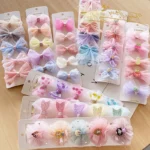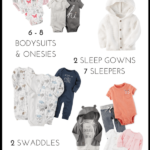Choosing the right fabric for your toddler’s sensitive skin is essential. Comfort and safety come first.
Toddlers have delicate skin that needs extra care. The wrong fabric can cause irritation or allergies. Parents often struggle to find the best materials that are both soft and safe. This blog will guide you through the best toddler-friendly fabrics for sensitive skin.
We’ll explore options that keep your little one comfortable and happy. From natural fibers to hypoallergenic choices, you’ll learn what to look for and why it matters. Ensuring your toddler’s comfort and well-being has never been easier. Let’s dive into the world of toddler-friendly fabrics that are gentle on sensitive skin.

Credit: www.amazon.com
Introduction To Toddler-friendly Fabrics
Choosing the right fabric for your toddler’s clothes can be challenging. Sensitive skin needs gentle and soft materials. This blog explores fabrics that keep your little one comfortable.
Why Fabric Choice Matters
Fabric choice directly affects your toddler’s skin. Some fabrics can irritate, causing rashes or discomfort. You want your child to feel cozy and safe in their clothes.
Breathable fabrics are essential. They allow air to circulate, preventing sweat buildup. This keeps the skin dry and reduces the risk of irritation.
Natural fibers are often the best choice. They are soft, hypoallergenic, and less likely to cause skin reactions. Let’s look at some toddler-friendly fabrics.
Common Skin Sensitivities In Toddlers
Toddlers often have delicate skin. Common sensitivities include eczema, allergic reactions, and dermatitis. These conditions require extra care in fabric selection.
Eczema causes red, itchy patches. Fabrics must be smooth and non-irritating. Allergic reactions can occur from dyes or chemicals in some fabrics. Opt for organic materials.
Dermatitis results from contact with irritants. Choosing the right fabric can prevent flare-ups. Understanding these sensitivities helps in making informed choices.
Recommended Toddler-friendly Fabrics
| Fabric | Benefits |
|---|---|
| Cotton | Soft, breathable, hypoallergenic |
| Bamboo | Soft, moisture-wicking, antibacterial |
| Organic Cotton | Chemical-free, gentle on skin |
| Silk | Luxurious, smooth, hypoallergenic |
These fabrics ensure comfort and safety for your toddler’s sensitive skin. Choose wisely to keep your little one happy and rash-free.
Organic Cotton
Choosing the right fabric for your toddler’s sensitive skin is crucial. Organic cotton stands out as an excellent choice. It is soft, breathable, and free from harmful chemicals. Let’s dive into the benefits and best care practices for this wonderful fabric.
Benefits Of Organic Cotton
Organic cotton offers many advantages for toddlers with sensitive skin. Here are some key benefits:
- Hypoallergenic: Reduces the risk of allergies and skin irritation.
- Breathable: Allows air to flow, keeping the skin cool and dry.
- Chemical-Free: Grown without synthetic pesticides and fertilizers.
- Durable: Strong fibers make clothes last longer.
- Eco-Friendly: Better for the environment and reduces pollution.
Best Practices For Care
Proper care will extend the life of your organic cotton garments. Follow these tips:
- Wash in Cold Water: Helps retain color and fabric strength.
- Use Mild Detergent: Avoid harsh chemicals that can irritate skin.
- Avoid Bleach: It can damage the fibers and reduce softness.
- Dry Naturally: Air drying is gentle on the fabric and the environment.
- Iron on Low: If needed, use a low setting to prevent burning the fabric.
By following these simple tips, you can keep your toddler’s clothes soft, comfortable, and safe.
Bamboo Fabric
Bamboo fabric is gaining popularity among parents for its exceptional benefits. This fabric is not only soft and gentle on a toddler’s sensitive skin but also has impressive sustainability features. Let’s dive into the details of why bamboo fabric is a great choice for your little one.
Sustainability And Softness
Bamboo fabric is made from the pulp of bamboo plants. These plants grow quickly and do not require pesticides or fertilizers. This makes bamboo a highly sustainable resource. The fabric produced from bamboo is incredibly soft. It feels like a mix of silk and cotton, providing a cozy feel for toddlers.
Parents prefer bamboo fabric for its hypoallergenic properties. It naturally repels dust mites and other allergens. This is essential for toddlers with sensitive skin or allergies. Bamboo fabric also has antibacterial qualities. This keeps the fabric fresh and free from unpleasant odors.
Ideal Uses For Toddlers
Bamboo fabric is versatile. It can be used in various toddler products. Here are some ideal uses:
- Clothing: Bamboo onesies, pajamas, and t-shirts are popular. They provide comfort and breathability.
- Bedding: Bamboo sheets and blankets are soft and cozy. They help regulate temperature, keeping toddlers comfortable.
- Diapers: Bamboo cloth diapers are gentle on sensitive skin. They are also eco-friendly.
- Towels: Bamboo towels are super absorbent. They are perfect for bath time and gentle on delicate skin.
Choosing bamboo fabric for your toddler ensures comfort and care. Its natural properties make it a safe and sustainable choice.

Credit: www.instagram.com
Modal Fabric
Modal fabric is a wonderful choice for toddlers with sensitive skin. Made from beech tree pulp, modal is a semi-synthetic fabric. It is known for its softness and smooth texture. This makes it perfect for little ones who need extra comfort.
Comfort And Breathability
Modal fabric offers exceptional comfort. It is soft, smooth, and gentle on sensitive skin. This is ideal for toddlers. Modal is also breathable. It allows air to flow through, keeping your child cool. This helps prevent rashes and irritation.
The fabric feels similar to cotton. However, it is even softer. This makes it a favorite for parents. Toddlers stay comfortable all day long. Modal fabric also absorbs moisture well. It keeps your child dry and happy. This is a big plus for active toddlers.
How To Wash Modal
Washing modal fabric is easy. Always check the care label first. Use cold water and a gentle cycle. This helps maintain the fabric’s softness. Avoid using bleach. It can damage the fibers. Instead, use a mild detergent.
When drying, opt for a low heat setting. High heat can shrink the fabric. It is best to air dry modal garments. Lay them flat to avoid stretching. If you must iron, use a low setting. Ironing inside out will protect the fabric.
With proper care, modal fabric stays soft and durable. This ensures your toddler’s comfort for a long time.
Hemp Fabric
Hemp fabric is gaining popularity as a toddler-friendly choice. Its natural properties make it suitable for sensitive skin. Hemp fabric is derived from the fibers of the hemp plant. It offers unique benefits that cater to the needs of young children.
Durability And Softness
Hemp fabric is known for its strength. It can withstand rough play without tearing easily. This durability ensures longer-lasting clothes for active toddlers. Despite its toughness, hemp fabric is also soft. It becomes softer with each wash, providing comfort for delicate skin.
Environmental Impact
Hemp is an eco-friendly crop. It requires less water compared to cotton. It also grows quickly and does not deplete the soil. Hemp farming uses fewer pesticides, reducing chemical exposure. This makes hemp fabric a sustainable choice for environmentally-conscious parents.
Linen For Toddlers
Linen is an excellent fabric for toddlers with sensitive skin. This natural fabric is known for its softness, breathability, and durability. Linen keeps your little one comfortable and stylish throughout the day.
Cooling Properties
Linen is perfect for keeping toddlers cool. The fabric is lightweight and breathable, allowing air to circulate freely. This helps to prevent overheating and keeps your child comfortable, especially during warm weather.
Linen also wicks moisture away from the skin. It absorbs sweat and dries quickly, ensuring your toddler stays dry and comfortable. This is especially beneficial for active toddlers who love to play and explore.
Styling Tips For Linen
Linen is versatile and easy to style. Here are some tips for dressing your toddler in linen:
- Layering: Pair a linen shirt with a soft cotton undershirt for added warmth and comfort.
- Mix and Match: Combine linen pants with a colorful cotton top for a fun and playful look.
- Accessories: Add a cute hat or headband to complete the outfit and protect your toddler from the sun.
Choose neutral colors like beige, white, or pastel shades. These colors complement the natural texture of linen and are perfect for any occasion. Linen is easy to care for and becomes softer with each wash, making it a great choice for your toddler’s wardrobe.
Wool And Merino Wool
Wool and Merino wool are excellent choices for toddlers with sensitive skin. These natural fabrics offer many benefits, especially during colder months. They keep your child comfortable and happy.
Natural Warmth
Wool provides natural insulation. It keeps your toddler warm without overheating. This fabric is breathable, allowing air to circulate. Your child stays cozy but not sweaty. Merino wool, in particular, is soft and fine. It offers warmth without bulk. Perfect for layering in winter.
Preventing Itchiness
Parents often worry about wool causing itchiness. Merino wool solves this problem. The fibers are much finer and softer than regular wool. They do not irritate sensitive skin. This makes Merino wool a top choice for toddlers. It reduces the risk of rashes and discomfort. Your child can enjoy the comfort without the itch.

Credit: amormama.com.au
Silk For Sensitive Skin
Choosing the right fabric for your toddler’s sensitive skin can be a challenge. Silk is an excellent option due to its natural properties. It is known for being gentle and soft. This makes it perfect for delicate skin.
Luxurious Feel
Silk has a luxurious feel that is hard to match. It is incredibly soft and smooth. Toddlers with sensitive skin will love its comfort. Silk’s natural fibers help regulate body temperature. This keeps your child cool in summer and warm in winter. It also reduces irritation and itching.
Care Instructions
Caring for silk requires some extra attention. Here is a simple guide:
- Hand wash in cold water.
- Use a mild detergent.
- Do not wring or twist.
- Air dry flat on a towel.
- Avoid direct sunlight to prevent fading.
- Iron on low heat if needed.
Following these steps will keep your toddler’s silk clothes looking new. Proper care ensures the fabric remains soft and gentle on their skin.
Blended Fabrics
Blended fabrics are a popular choice for toddler clothing. These fabrics combine natural and synthetic fibers to create a material that offers the best of both worlds. Parents often choose blended fabrics for their durability, comfort, and ease of care. Let’s explore the pros and cons of blended fabrics for toddlers, and discover the best blends suited for their sensitive skin.
Pros And Cons
Blended fabrics offer a range of benefits but also have some downsides. Here are the key points:
| Pros | Cons |
|---|---|
|
|
Best Blends For Toddlers
Choosing the right blend is crucial for your toddler’s comfort. Here are some of the best options:
- Cotton-Polyester: This blend offers the softness of cotton and the durability of polyester. It is also wrinkle-resistant and easy to care for.
- Cotton-Bamboo: Combining cotton with bamboo fibers provides a soft, breathable, and hypoallergenic fabric. It is perfect for sensitive skin.
- Cotton-Lycra: This blend adds a bit of stretch, making it ideal for active toddlers. It is comfortable and allows for easy movement.
Parents can select the best blend based on their toddler’s specific needs. Always check the fabric content on clothing labels. This ensures your child’s comfort and skin health.
Avoiding Irritants In Fabrics
For toddlers with sensitive skin, choosing the right fabrics is crucial. Certain materials can cause irritation, leading to discomfort and rashes. It’s essential to know which fabrics to avoid and how to select the best ones for your little one.
Common Irritants
Several materials and additives can irritate sensitive skin. Understanding these irritants helps you make better fabric choices.
- Synthetic fibers: These include polyester, nylon, and acrylic. They often cause skin reactions due to their non-breathable nature.
- Harsh chemicals: Some fabrics are treated with chemicals to make them wrinkle-free or stain-resistant. These chemicals can irritate sensitive skin.
- Dyes and colorants: Brightly colored fabrics may contain dyes that can be harsh on delicate skin.
- Rough textures: Fabrics with rough textures like wool can cause friction and irritation.
Tips For Choosing Safe Fabrics
Selecting the right fabrics can significantly reduce skin irritation for your toddler. Here are some tips to help you choose wisely:
- Opt for natural fibers: Choose fabrics like cotton, bamboo, and silk. These materials are gentle on the skin and breathable.
- Look for organic options: Organic fabrics are free from harmful chemicals and pesticides, making them safer for sensitive skin.
- Check for certifications: Certifications like GOTS (Global Organic Textile Standard) ensure the fabric meets stringent safety standards.
- Avoid heavy dyes: Go for light-colored or undyed fabrics to minimize the risk of irritation.
- Feel the texture: Ensure the fabric is soft and smooth. Avoid materials that feel rough or abrasive.
By following these tips, you can ensure your toddler’s clothes are comfortable and safe for their sensitive skin.
Certifications To Look For
Finding the right fabric for your toddler’s sensitive skin can be challenging. Certifications can help you identify safe and gentle materials. Let’s explore two key certifications you should consider: Oeko-Tex Standard and GOTS Certification.
Oeko-tex Standard
The Oeko-Tex Standard ensures fabrics are free from harmful substances. This certification tests for chemicals that might irritate your toddler’s skin. Items with this label have passed strict safety checks.
Why choose Oeko-Tex certified fabrics?
- They are tested for over 100 harmful substances.
- They ensure product safety for sensitive skin.
- They promote sustainable and eco-friendly production.
Gots Certification
The Global Organic Textile Standard (GOTS) is another important certification. It guarantees that fabrics are organic and produced in an environmentally friendly way. GOTS certification covers the entire supply chain, from harvesting to manufacturing.
Benefits of GOTS certified fabrics:
- They are made from organic fibers.
- They follow strict environmental and social criteria.
- They are safe for your toddler’s sensitive skin.
Choosing fabrics with these certifications ensures your toddler’s comfort and safety.
Shopping Tips For Parents
Choose soft, breathable materials like organic cotton to keep toddlers comfortable. These fabrics prevent irritation on sensitive skin. Ensure clothes are gentle and safe for daily wear.
Shopping for fabrics that suit your toddler’s sensitive skin can be tricky. Parents need to choose materials that are soft, breathable, and hypoallergenic. This section offers practical tips to help you make informed decisions.Where To Buy
Look for stores that specialize in baby clothing. These stores often carry fabrics suitable for sensitive skin. Online marketplaces also offer a wide range of options. Check customer reviews to gauge fabric quality. Some brands focus on organic and natural fibers. These are excellent choices for toddlers with sensitive skin. Local boutiques can be hidden gems. They often stock unique, high-quality fabrics.Questions To Ask Retailers
Before buying, ask the retailer about the fabric’s origin. Where is it sourced from? Inquire if the fabric is certified organic. Certification ensures the fabric is free from harmful chemicals. Ask about the washing instructions. Some fabrics require special care. Find out if the fabric is pre-shrunk. This helps avoid size issues after washing. Ask if they offer samples. Testing a small piece can help you decide. By following these tips, parents can make better choices. Your toddler’s skin will thank you.Diy Fabric Treatments
Choosing the right fabric for your toddler is crucial, especially for those with sensitive skin. DIY fabric treatments can help make fabrics more comfortable and safe for your little one. These treatments can soften fabrics and remove any potential irritants. Let’s explore some simple and effective DIY fabric treatments.
Natural Softeners
Using natural softeners can make fabric gentle on your toddler’s skin. Vinegar is a great option. It softens clothes without the harsh chemicals found in commercial products.
- Add 1/2 cup of white vinegar to the rinse cycle.
- Vinegar helps remove soap residue and softens the fabric.
Baking soda is another excellent natural softener. It balances pH levels and eliminates odors.
- Add 1/2 cup of baking soda to the wash cycle.
- Baking soda leaves fabrics feeling fresh and soft.
Homemade Fabric Washes
Homemade fabric washes can be gentle on sensitive skin. They use simple and safe ingredients.
- Mix 1 cup of castile soap with 1 cup of water.
- Add 1/4 cup of baking soda and 10 drops of essential oil.
- Shake well and use 1/4 cup per load of laundry.
This homemade wash is gentle and free from harsh chemicals.
Another effective homemade wash uses soap nuts. Soap nuts are natural and non-toxic.
- Place 5-6 soap nuts in a small cloth bag.
- Put the bag in the washing machine with your clothes.
- Soap nuts can be reused for several loads.
These homemade fabric washes help keep your toddler’s clothes soft and safe.
Frequently Asked Questions
What Fabrics Are Best For Toddlers With Sensitive Skin?
Cotton, bamboo, and organic wool are gentle. They prevent irritation. Soft and breathable. Perfect for toddlers.
Why Is Cotton Good For Sensitive Skin?
Cotton is natural and hypoallergenic. It absorbs moisture. Keeps skin dry. Soft and comfortable. Great choice.
Is Bamboo Fabric Safe For Toddlers?
Yes, bamboo fabric is soft and breathable. It’s hypoallergenic. Reduces skin irritation. Good for sensitive skin.
Can Organic Wool Be Used For Toddlers?
Yes, organic wool is natural and soft. It regulates temperature. Keeps toddlers comfortable. Suitable for sensitive skin.
How To Choose Fabrics For Sensitive Skin?
Look for natural, hypoallergenic fabrics. Avoid synthetic materials. Check for softness. Ensure breathability. Read labels carefully.
Conclusion
Choosing the right fabric for your toddler matters. It helps protect their sensitive skin. Cotton, bamboo, and silk are great options. These fabrics are gentle and breathable. They keep your child comfortable all day. Always check labels for natural materials.
Avoid harsh chemicals and synthetic fibers. Your toddler deserves the best care. Soft fabrics can make a big difference. Happy parenting!







